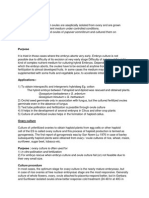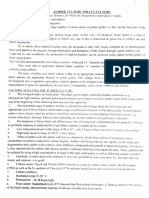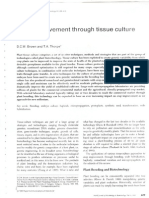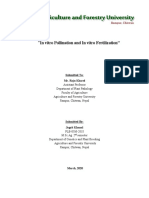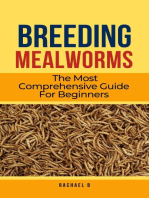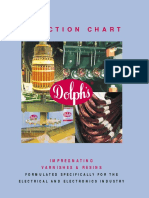(23279834 - HortScience) A Review of Plant Embryo Culture
(23279834 - HortScience) A Review of Plant Embryo Culture
Uploaded by
Sora KunCopyright:
Available Formats
(23279834 - HortScience) A Review of Plant Embryo Culture
(23279834 - HortScience) A Review of Plant Embryo Culture
Uploaded by
Sora KunOriginal Title
Copyright
Available Formats
Share this document
Did you find this document useful?
Is this content inappropriate?
Copyright:
Available Formats
(23279834 - HortScience) A Review of Plant Embryo Culture
(23279834 - HortScience) A Review of Plant Embryo Culture
Uploaded by
Sora KunCopyright:
Available Formats
Tusa, N., J.W. Grosser, and F.G. Gmitter, Jr. 1990. Plant regeneration of Vardi, A., A.
, A., A. Breiman, and E. Galun. 1987. Citrus cybrids: Production by
‘Valencia’ sweet orange, ‘Femminello’ lemon, and the interspecific so- donor–recipient protoplast-fusion and verification by mitochondrial-DNA
matic hybrid following protoplast fusion. J. Amer. Soc. Hort. Sci. 115:1043– restriction profiles. Theor. Applied Genet. 75:51–58.
1046. Vardi, A. and E. Galun. 1988. Recent advances in protoplast culture of
Vardi, A., P. Arzee-Gonen, A. Frydman-Shani, and S. Bleichman. 1989. horticultural crops: Citrus. Scientia Hort. 37:217–230.
Protoplast fusion mediated transfer of organelles from Microcitrus and Vardi, A., P. Spiegel-Roy, and E. Galun. 1982. Plant regeneration from Citrus
Citrus and regeneration of novel alloplasmic trees. Theor. Applied Genet. protoplasts: Variability in methodological requirements among cultivars
78:741–747. and species. Theor. Applied Genet. 62:171–176.
A Review of Plant Embryo Culture
Mark P. Bridgen
Department of Plant Science, U-67, 1376 Storrs Road, University of Connecticut, Storrs, CT 06269
Tapping germplasm resources to improve cultivated plants de- coconut milk. This discovery ultimately led to understanding the
pends on introducing natural variability through traditional and bio- importance of reduced N in the form of amino acids for embryo
technological breeding methods. Intervarietal and interspecific crosses, culture.
followed by selection, have accounted for the improvement in quality Since the early 1940s, embryo culture has been used increasingly
and yield potential of practically all major crops (Raghavan, 1986). to understand the physical and nutritional requirements for embryonic
One biotechnological technique that has been beneficial is embryo development, bypass seed dormancy, shorten the breeding cycle, test
culture. seed viability, provide material for micropropagation, and rescue
Embryo culture involves isolating and growing an immature or immature hybrid embryos from incompatible crosses (Hu and Wang,
mature zygotic embryo under sterile conditions on an aseptic nutrient 1986).
medium with the goal of obtaining a viable plant. The basic premise for
this technique is that the integrity of the hybrid genome is retained in APPLICATIONS
a developmentally arrested or an abortive embryo and that its potential
to resume normal growth may be realized if supplied with the proper Embryo culture is one of the earliest forms of in vitro culture
growth substances. The technique depends on isolating the embryo applied to practical problems and is probably the tissue culture
without injury, formulating a suitable nutrient medium, and inducing technique that has proven of greatest value to breeders (Dunwell,
continued embryogenic growth and seedling formation. 1986). Its major application in plant breeding has been for interspecific
The culture of immature embryos is used to rescue embryos that hybridization.
would normally abort or that would not undergo the progressive Many unsuccessful crosses result from embryo abortion. Early
sequence of ontogeny. This process is difficult due to the tedious embryo abortion occurs primarily because the endosperm fails to
dissection necessary and the complex nutrient medium requirements. develop properly (Hu and Wang, 1986). With interspecific crosses,
Success with this type of culture depends strongly on the developmen- intergeneric crosses, and crosses between diploids and tetraploids, the
tal stage of the embryo when it is isolated (Monnier, 1978; Raghavan, endosperm often develops poorly or not at all. By aseptically culturing
1980). the embryo in a nutrient medium, this problem may be overcome.
The culture of mature embryos from ripened seeds is used to Embryos of some nonviable hybrids may possess the potential for
eliminate seed germination inhibitors or to shorten the breeding cycle initiating development by avoiding postzygotic barriers within the
if, for example, dormancy is a problem. This culture is easy and only mother plant. Several successful cases have been documented with
requires a simple nutrient medium with agar, sugar, and minerals. embryos arising from interspecific hybrids and intergeneric hybrids
(Ramming, 1990; Sharma and Gill, 1983; Williams, 1980; Williams
HISTORY and De Lautour, 1980; Williams et al., 1982).
Embryo culture can shorten the breeding cycle by overcoming
Embryo culture, sometimes called embryo rescue, is an in vitro dormancy in seeds. Dormancy may be caused by endogenous inhibi-
technique that has been used for more than half a century to save the tors, light requirements, low temperatures, dry storage requirements,
hybrid products of fertilization when they might otherwise degenerate. and embryo immaturity (Yeung et al., 1981). Seed dormancy factors
Success was first achieved in 1904 by Hannig who obtained viable may be localized in the seedcoat, the endosperm, or both. By removing
plants from mature embryos of two crucifers that were isolated the embryos from the influences of these factors, the embryos germi-
aseptically and grown on a mineral salt medium supplemented with nate and grow quickly and the breeding cycle is shortened. Isolated
sugar (Norstog, 1979). In 1924, Dietrich cultured mature and imma- embryos can also be vernalized and may, in some instances, reduce the
ture embryos of various plant species to determine whether they could generation time by 40 days (Sharma and Gill, 1983).
still germinate without completing the dormancy period. He reported In addition to the applied uses of embryo culture, the procedure is
that the mature embryos grew immediately, circumventing dormancy. useful in basic studies. Growing embryos outside the ovule (ex ovulo)
The immature embryos germinated precociously without further em- is an excellent way to study the nutrition and metabolism of the
bryo development. Laibach first described zygotic embryo culture for embryos at various stages of development. The technique can also be
interspecific hybridization in 1925. He observed that seeds from used to examine the growth requirements of embryos, the effects of
interspecific crosses between Linum perenne L. x Linum austriacum phytohormones and environmental conditions on zygotic embryogen-
L. were nonviable; however, if embryos were excised early during esis, and the regeneration potentials of whole embryos and their
seed development and cultured in vitro, then embryo abortion was segments (Yeung et al., 1981). Embryo culture can be used to localize
overcome. Later, van Overbeek et al. (1941) discovered that small sites of germination promoters and inhibitors, for studies of embryo-
Datura hybrid embryos could be grown in culture on media containing genesis, and for cryopreservation (Grout, 1986).
Embryo culture can be used to produce haploids through eliminat-
Storrs Agricultural Experiment Station no. 1503. The cost of publishing this ing chromosomes following distant hybridization. This can occur by
paper was defrayed in part by the payment of page charges. Under postal rescuing haploid maternal embryos in which the paternal chromo-
regulations, this paper therefore must be hereby marked advertisement solely somes have been eliminated. In these situations, fertilization occurs,
to indicate this fact. but the pollen parent chromosomes are subsequently eliminated by the
HORTS CIENCE, VOL. 29(11), NOVEMBER 1994 1243
WORKSHOP
seed parent. The viability of the haploid embryo can only be achieved embryo implantation or transplantation, have been adapted to other
through embryo culture. Chromosome doubling of the rescued em- species (Williams, 1980; Williams and De Lautour, 1980). By using
bryo produces a homozygote monoploid. embryo rescue, one can achieve a 30% to 40% success rate with
Embryo culture can be used to propagate plants vegetatively. intergeneric crosses compared to a 1% success rate when embryo–
Embryos from genera that have both juvenile and adult characteristics nurse endosperm transplants are not used.
are used as starting material for vegetative propagation. Embryos are Small or young embryos that abort at early stages of development
responsive because they are juvenile. With the Poaceae, organogen- are often difficult to isolate. The nutritional requirements of young
esis occurs easily from juvenile callus tissue. Conifer propagation via embryos vary greatly and the chances of damaging the embryos are
immature calli derived from young embryos and axillary shoot forma- great. In such situations, it may be possible to rescue embryos by ovary
tion is also easy. A major problem with this technique, however, is that or ovule culture methods (Rangan, 1984). Ovaries are excised after
clones are not produced from the zygotic material unless the embryos pollination and the calyx, corolla, and stamens are removed. The ovary
have developed from nucellar tissue, as in many types of Citrus. is surface-sterilized and cultured with the cut end of the pedicel
Embryo culture can be used to study precocious germination, the inserted into the nutrient medium. If all goes well, the ovary then
germination of embryos before the completion of normal embryo develops into a fruit with fully developed seeds. For ovule culture, the
development. Usually, precocious germination causes the formation sterilized ovary is opened and the fertilized ovules are scooped out and
of weak seedlings. To understand the factors that regulate the orderly transferred to the surface of the culture medium. The reasons for the
development of embryos in nature, embryos can be cultured under successful recovery of hybrids from ovary or ovule culture rather than
various conditions to determine what simulates embryological devel- through embryo culture are probably related to nutritional and physi-
opment. Precocious germination occurs because inhibitors are lost cal factors and protection of the embryo by the maternal or sporophytic
when the testa is removed or because the negative osmotic potential is tissues.
a higher value in vivo. Precocious germination has been prevented in Light and temperature are two environmental factors that are of
Prunus through ovule culture, where the integument acts as a natural major concern in embryo culture. Embryos sometimes grow best when
inhibitor (Ramming, 1985). maintained in darkness for the first 1 to 2 weeks of culture and then
Embryo culture has been very useful in determining seed viability. transferred to light to allow chlorophyll formation. Isolated embryos
This use arose out of early findings that there was a good correlation frequently germinate in a wider temperature range than intact seeds.
between the growth of excised embryos of non-after-ripened peach The optimum temperature depends on plant species, but normally a
[Prunus persica (L.) Batsch.] seeds and germination of the after- high range of 25 to 30C is used (Narayanaswamy and Norstog, 1964).
ripened seeds (Tukey, 1944). Embryo culture allows the rapid testing Some embryos, from species such as Lilium, require a lower tempera-
of seed viability when seed dormancy can be circumvented. ture, i.e., 17C, and others require a cold treatment of 4C to break
dormancy (Pierik, 1987).
TECHNIQUES The growth conditions of the mother plant are also a consideration
in embryo culture. The endosperm and the cotyledons will develop
In most situations, embryos are located in the sterile environment more if the mother plant is grown under well-controlled conditions;
of the ovule and surface sterilization of embryos is not necessary. embryo growth will consequently be promoted.
Instead, entire ovules or ovaries are surface-sterilized and then em-
bryos are removed aseptically from the surrounding tissues. Since the MEDIA
embryo is often well-protected by surrounding tissues, harsh proce-
dures may be used in surface disinfection. Thus, axenic cultures of Dieterich (1924) showed that mature embryos could grow nor-
embryos are often easily established. Direct disinfection of embryos is mally on a semisolid medium containing only Knop’s mineral salts
needed if seedcoats are cracked or if endophytic pathogens exist inside and 2.5% to 5% sucrose. However, many scientists believe that the
the seedcoats, as with fescue (Festuca spp. L.), corn (Zea mays L.), and most important aspect of embryo culture is medium selection. Several
dogwood (Cornus spp. L.) seeds. formulations of mineral salts have been used for embryo culture
The dissection of the embryos can produce problems. Large without much critical evaluation of the role of individual elements
embryos are not difficult to excise. However, small embryos require (Bhojwani and Razdan, 1983). Murashige and Skoog (1962) and
the use of microdissecting tools and a dissecting microscope to excise Gamborg’s B5 medium (Gamborg et al., 1968), with certain degrees
without injury. Embryos are easily damaged when the seedcoat is cut; of modification, are the most widely used basal media in embryo
it is also important that the excised embryo does not become desiccated culture.
during culture (Rangan, 1984). The exact nutritional requirement depends on the stage of embryo
The process of excising immature embryos varies with species. development. Raghavan (1966) identified two phases of embryo
However, many times an incision can be made at the micropylar end development. In the heterotrophic phase, the young embryo depends
of the young ovule and pressure applied at the opposite end to force the on the endosperm and the surrounding maternal tissues, and requires
embryo out through the opening. If liquid endosperm surrounds the a more complex medium and higher osmotic pressure than older
embryo, the pressure it exerts may injure the fragile embryonic tissue embryos. The continued development of young embryos requires
if caution is not exercised. When heart-stage and younger embryos are complex media supplemented with combinations of vitamins, amino
excised, it is important to keep the suspensors intact (Hu and Wang, acids, growth hormones, and, in some cases, natural extracts, such as
1986). tomato juice and coconut milk, to support development.
During the autotrophic phase, the second stage of embryo growth,
REQUIREMENTS FOR SUCCESS the embryo is metabolically capable of synthesizing substances re-
quired for its growth from the salts and sugar. In this phase, embryos
Successful development of an embryo depends on many factors. can germinate and grow on a simple inorganic medium supplemented
As with most other processes, the plant genotype greatly influences with a carbon source, such as sucrose.
success. Embryos of some species are easier to grow in culture than are Ammonium nitrate and potassium nitrate are the most frequently
others, and differences sometimes occur between closely related used sources of inorganic N in embryo culture. Ammonium in the
cultivars (Collins and Grosser, 1984; Rangan, 1984). medium is essential or preferential for proper growth and differentia-
As already indicated, small embryos are difficult to grow in vitro. tion of immature embryos (Matsubara, 1964; Umbeck and Norstog,
Specialized techniques can be used to improve success. The use of 1979). Ammonium usually is combined with an organic acid, particu-
“nurse” endosperm involves inserting a hybrid embryo into an en- larly with malate or citrate anions. Among various amino acids,
dosperm dissected from a normally developing, self-pollinated ovule glutamine and asparagine are the most effective (Sanders and
from one of the parents or a third species. The embryo and endosperm Burkholder, 1948). Casein hydrolysate is a complex mixture of amino
are transferred together to the surface of the culture medium (Williams acids and is commonly used in embryo culture media to stimulate
et al., 1982). Modified versions of the nurse endosperm, such as growth. Vitamins, such as biotin, thiamine, pantothenic acid, nicotinic
1244 HORTSCIENCE, VOL. 29(11), NOVEMBER 1994
acid, ascorbic acid, inositol, and pyroxidine, are commonly added, but Literature Cited
have not been proven to be essential.
Adding amino acids to the culture medium may stimulate embryo
Bhojwani, S.S. and M.K. Razdan. 1983. Plant tissue culture: Theory and
growth (Bhojwani and Razdan, 1983). Glutamine is the most effective practice. Elsevier, Amsterdam.
amino acid for cultured embryo growth (Monnier, 1978). Asparagine Cameron-Mills, V. and C.M. Duffus. 1977. The in vitro culture of immature
may also enhance embryo growth (Hannig, 1904), but it can be barley embryos on different culture media. Ann. Bot. 41:1117–1127.
inhibitory (Matsubara, 1964). Casein hydrolysate is a complex mix- Collins, G.B. and J.W. Grosser. 1984. Culture of embryos, p. 241–257. In: I.K.
ture of 18 amino acids that has been widely used as an additive to Vasil (ed.). Cell culture and somatic cell genetics of plants. vol. 1.
embryo culture media. When added alone to a medium, none of the Laboratory procedures and their applications. Academic, New York.
amino acids match the beneficial effect of casein hydrolysate (Sanders Dietrich, K. 1924. Über Kultur von Embryonen ausserhalb des Samens. Flora
and Burkholder, 1948). However, work with the induction and matu- (Jena) 117:379–417.
ration of somatic embryos demonstrates that amino acids such as Dunwell, J.M. 1986. Pollen, ovule and embryo culture as tools in plant
proline, serine, and glutamine can replace casein hydrolysate. breeding, p. 375–404. In: L.A. Withers and P.G. Alderson (eds.). Plant
The landmark work of van Overbeek et al. (1942) demonstrated tissue culture and its agricultural applications. Butterworths, London.
that embryos younger than the post-torpedo stage could be cultured by Gamborg, O.L., R.A. Miller, and K. Ojima. 1968. Nutrient requirements of
adding the liquid endosperm of coconut to the culture medium. By suspension cultures of soybean root cells. Expt. Cell Res. 50:151–158.
modifying a medium to mimic the endosperm that surrounds immature Grout, B.W.W. 1986. Embryo culture and cryopreservation for the conserva-
embryos in the ovule, success was obtained where it had not been tion of genetic resources of species with recalcitrant seed, p. 303–309. In:
possible previously. The growth-promoting factor in the coconut milk L.A. Withers and P.G. Alderson (eds.). Plant tissue culture and its agricul-
was referred to as “embryo factor.” By using coconut milk in media for tural applications. Butterworths, London.
Hannig, E. 1904. Zur Physiologie pflanzlicher Embryonen. I. Über die Kultur
young embryos, precocious germination can be avoided. Other natural
von Cruciferen-embryonen ausserhalb des Embryosacks. Bot. Ztg. 62:45–
substances, such as skim milk, dried brewer’s yeast (malt extract),
80.
casein hydrolysate, and diffusates from the seeds of several plant Hu, C. and P. Wang. 1986. Embryo culture: Technique and applications, p. 43–
species, can substitute for coconut milk, depending on the species 96. In: D.A. Evans, W.R. Sharp, and P.V. Ammirato (eds.). Handbook of
under investigation (Bhojwani and Razdan, 1983). Although synthetic plant cell culture. vol. 4. Macmillan, New York.
media are used, these natural plant extracts are still suitable amino acid Laibach, F. 1925. Das Taubwerden von Bastardsamen und die künstliche
sources for culturing immature embryos. A purely synthetic medium Aufzucht früh absterbender Bastardembryonen. Z. Bot. 17:417–459.
can be developed to substitute for coconut milk by enriching White’s Matsubara, S. 1964. Effect of nitrogen compounds on the growth of isolated
(1934) medium with phosphate and fortifying with glutamine, alanine, young embryos of Datura. Bot. Mag. (Tokyo) 77:253–259.
and five other amino acids (Cameron-Mills and Duffus, 1977). Monnier, M. 1978. Culture of zygotic embryos, p. 277–286. In: T.A. Thorpe
Sucrose is the most commonly used C energy source for embryo (ed.). Frontiers of plant tissue culture 1978. Univ. of Calgary Press, Canada.
culture. Sucrose is primarily an energy source, although it also plays Murashige, T. and F. Skoog. 1962. A revised medium for rapid growth and
an important role in maintaining suitable osmotic potential of nutrient bioassays with tobacco tissue cultures. Physiol. Plant. 15:473–497.
media. Mature embryos are usually grown on media with 2% to 3% Narayanaswamy, S. and K. Norstog. 1964. Plant embryo culture. Bot. Rev.
sucrose, whereas immature embryos grow better at 8% to 12%, which 30:587–628.
mimic the high osmotic potential within the young embryo sac. Norstog, K. 1979. Embryo culture as a tool in the study of comparative and
Generally, the younger the excised embryo, the higher the medium developmental morphology, p. 179–202. In: W.R. Sharp, P.O. Larsen, E.F.
osmolarity required. Raghavan (1977, 1980) believes that this high Paddock, and V. Raghavan (eds.). Plant cell and tissue culture. Ohio State
osmolarity prevents precocious germination and keeps cells that are in Univ. Press, Columbus.
Pierik, R.L.M. 1987. In vitro culture of higher plants. Martinus Nijhoff,
a state of division from going into a state of elongation.
Dordrecht, Netherlands.
Agar is the most commonly used agent to solidify culture media.
Raghavan, V. 1966. Nutrition, growth and morphogenesis of plant embryos.
Concentrations of 0.5% to 1.5% are generally used for embryo culture Biol. Rev. 41:1–58.
(Hu and Wang, 1986). High concentrations of agar may inhibit growth Raghavan, V. 1977. Applied aspects of embryo culture, p. 375–397. In: J.
due to reduced water availability, quality of agar, or contaminating Reinert and Y.P.S. Bajaj (eds.). Applied and fundamental aspects of plant
salts. cell, tissue, and organ culture. Springer-Verlag, Berlin.
Plant growth regulators generally play a small role in embryo Raghavan, V. 1980. Embryo culture, p. 209–240. In: I.K. Vasil (ed.). Perspec-
culture. Exogenous auxins do not seem to be required for plant embryo tives in plant cell and tissue culture. Intl. Rev. Cytol., Suppl. 11B. Aca-
growth in vitro (Norstog, 1979). This observation supports reports that demic, New York.
somatic embryo induction is inhibited by high concentrations of Raghavan, V. 1986. Embryogenesis in angiosperms. Cambridge Univ. Press,
exogenous auxin in the medium and stimulated by low concentrations Cambridge, U.K.
or in its absence. Cytokinins, when used as the sole hormone, are Ramming, D.W. 1985. In ovulo embryo culture of early-maturing Prunus.
ineffective or only slightly promote young embryo growth. However, HortScience 20:419–420.
they promote growth and differentiation of embryos when they are Ramming, D.W. 1990. The use of embryo culture in fruit breeding. HortScience
combined with some auxins (Veen, 1963). Monnier (1978) suggests 25:393–398.
that hormones should not be added to embryo culture media as they Rangan, T.S. 1984. Culture of ovules, p. 227–231. In: I.K. Vasil (ed.). Cell
cause structural abnormalities. Auxins and cytokinins are not gener- culture and somatic cell genetics of plants. vol. 1. Laboratory procedures
ally used for embryo culture unless callus induction is needed. Gibber- and their applications. Academic, New York.
ellins sometimes stimulate precocious germination or are used to Sanders, M.E. and P.R. Burkholder. 1948. Influence of amino acids on
growth of Datura embryos in culture. Proc. Natl. Acad. Sci. USA 34:516–
overcome dormancy.
526.
Sharma, H.C. and B.S. Gill. 1983. New hybrids between Agropyron and wheat.
CONCLUSION 2. Production, morphology and cytogenetic analysis of F1 hybrids and
backcross derivatives. Theor. Appl. Genet. 66:111–121.
Embryo culture is a valuable in vitro tool for breeding. It is most Tukey, H.B. 1944. Excised-embryo method of testing the germinability of fruit
often used to rescue embryos from interspecific and intergeneric seed with particular reference to peach seed. Proc. Amer. Soc. Hort. Sci.
crosses and from embryos that do not fully develop naturally (as in 45:211–219.
early ripening and seedless fruit where the embryo aborts). The Umbeck, P.F. and K. Norstog. 1979. Effects of abscisic acid and ammonium ion
method also can be used to rescue seedless triploid embryos, produce on morphogenesis of cultured barley embryos. Bul. Torrey Bot. Club
haploids, overcome seed dormancy, or determine seed viability. It is 106:110–116.
useful in understanding embryo morphogenesis and precocious ger- van Overbeek, J., M.E. Conklin, and A.F. Blakeslee. 1941. Factors in coconut
mination. As research continues with this technique, new and valuable milk essential for growth and development of very young Datura embryos.
uses will be developed to assist the biotechnological breeding of plants. Science 94:350–351.
HORTS CIENCE, VOL. 29(11), NOVEMBER 1994 1245
WORKSHOP
van Overbeek, J., M.E. Conklin, and A.F. Blakeslee. 1942. Cultivation in vitro transplanted nurse endosperm for the production of interspecific hybrids in
of small Datura embryos. Amer. J. Bot. 29:472–477. pasture legumes. Bot. Gaz. (Chicago) 141:252–257.
Veen, H. 1963. The effect of various growth-regulators on embryos of Capsella Williams, E.G., I.M. Verry, and W.M. Williams. 1982. Use of embryo culture
bursapastoris growing in vitro. Acta Bot. Neerl. 12:129–171. in interspecific hybridization, p. 119–128. In: I.K. Vasil, W.R. Scowcroft,
White, P.R. 1934. Potentially unlimited growth of excised tomato root tips in and K.J. Frey (eds.). Plant improvement and somatic cell genetics. Aca-
a liquid medium. Plant Physiol. 9:585–600. demic, New York.
Williams, E. 1980. Hybrids between Trifolium ambiguum and T. hybridum Yeung, E.C., T.A. Thorpe, and C.J. Jensen. 1981. In vitro fertilization and
obtained with the aid of embryo culture. N.Z. J. Bot. 18:215–220. embryo culture, p. 253–271. In: T.A. Thorpe (ed.). Plant tissue culture:
Williams, E. and G. De Lautour. 1980. The use of embryo culture with Methods and applications in agriculture. Academic, New York.
1246 HORTSCIENCE, VOL. 29(11), NOVEMBER 1994
You might also like
- Juslin Sloboda HANDBOOK OF MUSIC AND EMOTION THEORY, RESEARCH, APPLICATIONSDocument5 pagesJuslin Sloboda HANDBOOK OF MUSIC AND EMOTION THEORY, RESEARCH, APPLICATIONSCRISTINA AIESTA YUSTENo ratings yet
- 2# Plant Cell and Tissue CultureDocument33 pages2# Plant Cell and Tissue CultureNuria Azmi Fadhila100% (1)
- UTSSSSDocument2 pagesUTSSSSRadzkia Salahuddin75% (12)
- Journals Hortsci 29 11 Article-P1243-PreviewDocument2 pagesJournals Hortsci 29 11 Article-P1243-Previewrohim uerifaNo ratings yet
- A Review of Plant Embryo CultureDocument4 pagesA Review of Plant Embryo CultureJas TalaraNo ratings yet
- Embryo Rescue in GrapesDocument24 pagesEmbryo Rescue in GrapesAditi SharmaNo ratings yet
- Biotech Note 2Document7 pagesBiotech Note 2bedant_sapNo ratings yet
- I.1 Overview of Haploidy: Sica Homozygous Diploid Lines From Naturally Occurring Haploids WereDocument5 pagesI.1 Overview of Haploidy: Sica Homozygous Diploid Lines From Naturally Occurring Haploids WereNavneet SamraNo ratings yet
- Article1380804808 - Reddy Et Al - Semilla Sintetica PDFDocument22 pagesArticle1380804808 - Reddy Et Al - Semilla Sintetica PDFearevalogaNo ratings yet
- Principle and Application of Plant Tissue CultureDocument25 pagesPrinciple and Application of Plant Tissue CultureAmrit Jyoti BorahNo ratings yet
- 760D84F31753Document5 pages760D84F31753Spam SpamNo ratings yet
- Lect-8 in Vitro Pollination, Fertilization and Embryo CultureDocument83 pagesLect-8 in Vitro Pollination, Fertilization and Embryo Culturethinkkethi710187% (23)
- Lect 8 in Vitro Pollination Fertilization and Embryo Culture PDFDocument83 pagesLect 8 in Vitro Pollination Fertilization and Embryo Culture PDFSachin Maurya100% (2)
- Types of Culture - Class NotesDocument14 pagesTypes of Culture - Class Notesjyomams100% (1)
- PBT NotesDocument5 pagesPBT NotesYogish HegdeNo ratings yet
- Crop Improvement Through Tissue CultureDocument7 pagesCrop Improvement Through Tissue CulturePrakasha T LNo ratings yet
- Embryo RescueDocument8 pagesEmbryo RescueFidlia AlimNo ratings yet
- 2327 9788 Article p747Document7 pages2327 9788 Article p747Afif FebrianNo ratings yet
- In Vitro Pollination and in Vitro Fertilization": An Assignment OnDocument13 pagesIn Vitro Pollination and in Vitro Fertilization": An Assignment OnJagrit KhanalNo ratings yet
- History of Plant Tissue CultureDocument14 pagesHistory of Plant Tissue CultureSTAR PRINTINGNo ratings yet
- Aula 5Document38 pagesAula 5Ana Patricia MartinsNo ratings yet
- Assignment-2: Embryo Rescue Technique and Its ApplicationDocument16 pagesAssignment-2: Embryo Rescue Technique and Its ApplicationNikita JainNo ratings yet
- Anther and Pollen CultureDocument25 pagesAnther and Pollen CultureMoharnab Sandillya100% (2)
- Presentation1 171022084035Document16 pagesPresentation1 171022084035Akkipero123No ratings yet
- Micropropagation Techniques in Horticultural Crops and Various Factors Affecting It A ReviewDocument5 pagesMicropropagation Techniques in Horticultural Crops and Various Factors Affecting It A Reviewchandu848125No ratings yet
- MicropropagationDocument2 pagesMicropropagationnida khanNo ratings yet
- MicropropagationDocument6 pagesMicropropagationEmmanuel OcanseyNo ratings yet
- Botany Unit 1Document16 pagesBotany Unit 1Hunter Gosai100% (1)
- Tissue cultureDocument29 pagesTissue culturedennis wambuguNo ratings yet
- By-Md. Zikurullah Shamim M.Sc. Agril. Biotech & Mol - Biology Instructor - Dr. Harsh Kumar Uni. Professor Dep. of Agril. Biotech & Mol - BiologyDocument20 pagesBy-Md. Zikurullah Shamim M.Sc. Agril. Biotech & Mol - Biology Instructor - Dr. Harsh Kumar Uni. Professor Dep. of Agril. Biotech & Mol - Biology12345676543No ratings yet
- Applications of Plant Tissue CultureDocument4 pagesApplications of Plant Tissue CultureSiddhesh Uday Sapre100% (2)
- Anther CultureDocument11 pagesAnther CultureVARTIKA KHATI100% (1)
- Ferrie 2011Document9 pagesFerrie 2011László SágiNo ratings yet
- Unit 4 - Haploid, Embryo, and Protoplast CultureDocument54 pagesUnit 4 - Haploid, Embryo, and Protoplast CultureAnonymous 3j6NRaSt267% (3)
- 014 Pragalbh Tiwari 53Document12 pages014 Pragalbh Tiwari 53ahmetkoseoglu24No ratings yet
- Bite260 - 202110 - C03 SsaDocument54 pagesBite260 - 202110 - C03 Ssaromulo remoNo ratings yet
- Positive Effect of in Vitro Embryo Rescue On Breaking The Dormancy of Wild Banana Seeds Compared To Direct Sowing in The GreenhouseDocument10 pagesPositive Effect of in Vitro Embryo Rescue On Breaking The Dormancy of Wild Banana Seeds Compared To Direct Sowing in The GreenhouseSol InvictusNo ratings yet
- In Vitro Crop BreedingDocument21 pagesIn Vitro Crop BreedingVictor JavierNo ratings yet
- Artificial Seed ProductionDocument17 pagesArtificial Seed Productionj131089No ratings yet
- Lecture 2 - Notes - Principle of Plant Breeding - Mode of ReproductionDocument7 pagesLecture 2 - Notes - Principle of Plant Breeding - Mode of ReproductionPaulino mariak AtemNo ratings yet
- The Production of Callus Capable of Plant Regeneration From Immature Embryos Zea MaysDocument11 pagesThe Production of Callus Capable of Plant Regeneration From Immature Embryos Zea Mayssiti.dede1973No ratings yet
- Micropropagation of Theobroma Cacao L Using SomatiDocument8 pagesMicropropagation of Theobroma Cacao L Using SomatiCarlos RomeroNo ratings yet
- The Recovery of Hawaiian Plant Species Using Embryo and Ovulo CultureDocument3 pagesThe Recovery of Hawaiian Plant Species Using Embryo and Ovulo CultureMicaela CaroliniNo ratings yet
- KameswaraRao2017 Article AReviewOfFactorsThatInfluenceTDocument14 pagesKameswaraRao2017 Article AReviewOfFactorsThatInfluenceTDunna DevisriNo ratings yet
- Anther and Pollen CultureDocument20 pagesAnther and Pollen CultureMDZIKRULLAHSHAMIMNo ratings yet
- Plant Biotechnology SeminarDocument16 pagesPlant Biotechnology Seminarj1310890% (1)
- BiotecnologiasDocument10 pagesBiotecnologiasSandra SharryNo ratings yet
- Micro PropagationDocument30 pagesMicro PropagationShreyaNo ratings yet
- 4 Achievements Made Through Tissue Culture in Agriculture, Horticulture and ForestryDocument5 pages4 Achievements Made Through Tissue Culture in Agriculture, Horticulture and ForestryAnandKuttiyanNo ratings yet
- Artigo Catasetum RodriguésiaDocument15 pagesArtigo Catasetum RodriguésiaJack Wild SoaresNo ratings yet
- Somatic Embryogenesis and Plant RegenerationDocument6 pagesSomatic Embryogenesis and Plant RegenerationmacroendrixNo ratings yet
- Biology Paper Plant Tissue Culture Aulia Putri KusumaDocument9 pagesBiology Paper Plant Tissue Culture Aulia Putri KusumaAulia Putri KusumaNo ratings yet
- M. Cresti Et Al. (Eds.), Sexual Plant Reproduction © Springer-Verlag Berlin Heidelberg 1992Document8 pagesM. Cresti Et Al. (Eds.), Sexual Plant Reproduction © Springer-Verlag Berlin Heidelberg 1992Hebatallah IsmailNo ratings yet
- Bio 309 - 0Document63 pagesBio 309 - 0okiprotich0No ratings yet
- Plant Tissue CultureDocument3 pagesPlant Tissue CulturepradeepNo ratings yet
- Tissue Culture and Its ApplicationsDocument17 pagesTissue Culture and Its ApplicationsoziaegamingNo ratings yet
- Ijair 3275 FinalDocument8 pagesIjair 3275 Finaloztrk.meltmNo ratings yet
- In Vitro Haploid and Dihaploid Production Via Unfertilized Ovule CultureDocument10 pagesIn Vitro Haploid and Dihaploid Production Via Unfertilized Ovule CultureKulwinder KaurNo ratings yet
- Plant BreedingDocument21 pagesPlant BreedingGautam PatidarNo ratings yet
- Somatic Embryogenesis for Micropropagation of Coconut (Cocos nucifera L.)From EverandSomatic Embryogenesis for Micropropagation of Coconut (Cocos nucifera L.)No ratings yet
- Small-scale Rearing of Anagasta kuehniella for Trichogramma ProductionFrom EverandSmall-scale Rearing of Anagasta kuehniella for Trichogramma ProductionNo ratings yet
- BG ST Eng Proc 012 - 3.1 BG STD Hipps SystemsDocument63 pagesBG ST Eng Proc 012 - 3.1 BG STD Hipps SystemsSrinivasan Rajenderan100% (1)
- 3098 OrigDocument30 pages3098 OriganasNo ratings yet
- 8: Molecular Biology and Gene Technology - Topic Questions: Year Series Paper NumberDocument18 pages8: Molecular Biology and Gene Technology - Topic Questions: Year Series Paper NumberOsama MaanNo ratings yet
- Hirac - FormDocument23 pagesHirac - Formoshcreu13 caragaNo ratings yet
- Highlights From DAWN: New York City, 2002: DAWN: The Warning NetworkDocument4 pagesHighlights From DAWN: New York City, 2002: DAWN: The Warning NetworklosangelesNo ratings yet
- Compressor Stage Pressure - Design & OptimizationDocument4 pagesCompressor Stage Pressure - Design & OptimizationAshwin ChandaranaNo ratings yet
- Woodpeckers: Distribution, Conservation, and Research in A Global PerspectiveDocument10 pagesWoodpeckers: Distribution, Conservation, and Research in A Global PerspectiveHadi ApriandiNo ratings yet
- Somatic Symptoms and Related Disorders, Dissociative Disorders and Psychotic DisorderDocument6 pagesSomatic Symptoms and Related Disorders, Dissociative Disorders and Psychotic DisorderMarco RagaNo ratings yet
- Blind To DetailsDocument6 pagesBlind To DetailsCarol TrầnNo ratings yet
- The 7 Feedback SkillsDocument4 pagesThe 7 Feedback SkillsArpit RathiNo ratings yet
- Thoracic and Abdominal TraumaDocument76 pagesThoracic and Abdominal Traumajhk0428100% (1)
- Iveco Engine User Manual F32 - ENDocument35 pagesIveco Engine User Manual F32 - ENMuhammed Imran KhalidNo ratings yet
- Locomotion and MovementDocument9 pagesLocomotion and MovementVishal JoshiNo ratings yet
- Chapter 11 Introduction To Organic Chemistry: AlkanesDocument11 pagesChapter 11 Introduction To Organic Chemistry: AlkanesLeila AgtarapNo ratings yet
- Pe11 Module 1 Stress ManagementDocument30 pagesPe11 Module 1 Stress ManagementFlordelyn CagadasNo ratings yet
- Parts Information: Eaton Hydraulics DivisionDocument4 pagesParts Information: Eaton Hydraulics DivisionFernando SabinoNo ratings yet
- TR Tourism Promotion Services NCIIDocument90 pagesTR Tourism Promotion Services NCIIBurgandy SantosNo ratings yet
- Motherly's Birth Class Printable Workbook: You've Got ThisDocument14 pagesMotherly's Birth Class Printable Workbook: You've Got ThisMarina GeorgianaNo ratings yet
- Unit 1: Introduction To Kinesiology and Sports BiomechanicsDocument70 pagesUnit 1: Introduction To Kinesiology and Sports BiomechanicsGOLDEN FIZZIK GYM100% (1)
- ISO 9001-2015-Awareness - ArabicDocument102 pagesISO 9001-2015-Awareness - Arabicايهاب امامNo ratings yet
- Lodge Tree 1994 Nutrient PulsesDocument4 pagesLodge Tree 1994 Nutrient Pulsesjyap_62No ratings yet
- Global Maintenance and Reliability Indicators SMRPDocument84 pagesGlobal Maintenance and Reliability Indicators SMRPSOHAIB100% (1)
- Dolphs Varnishs Resin ChartDocument3 pagesDolphs Varnishs Resin ChartFernando Rodriguez100% (1)
- BL-CIV-De-038-Rev - G - RS Administration Building - Detail Architect - Sheet 5 of 5Document1 pageBL-CIV-De-038-Rev - G - RS Administration Building - Detail Architect - Sheet 5 of 5ilijarskNo ratings yet
- STD5 Inter Disciplinary AssignmentDocument3 pagesSTD5 Inter Disciplinary AssignmentOmkar GitteNo ratings yet
- D 5250 - 00 - RduyntatmdaDocument4 pagesD 5250 - 00 - RduyntatmdaKelvin Ramírez MartínezNo ratings yet
- Pipe Network Analysis: Chemical Engineer's GuideDocument12 pagesPipe Network Analysis: Chemical Engineer's Guidepuyang48No ratings yet
- Starbucks Coffee-In Bangladesh-MarketingDocument22 pagesStarbucks Coffee-In Bangladesh-MarketingNusrat SharminNo ratings yet






